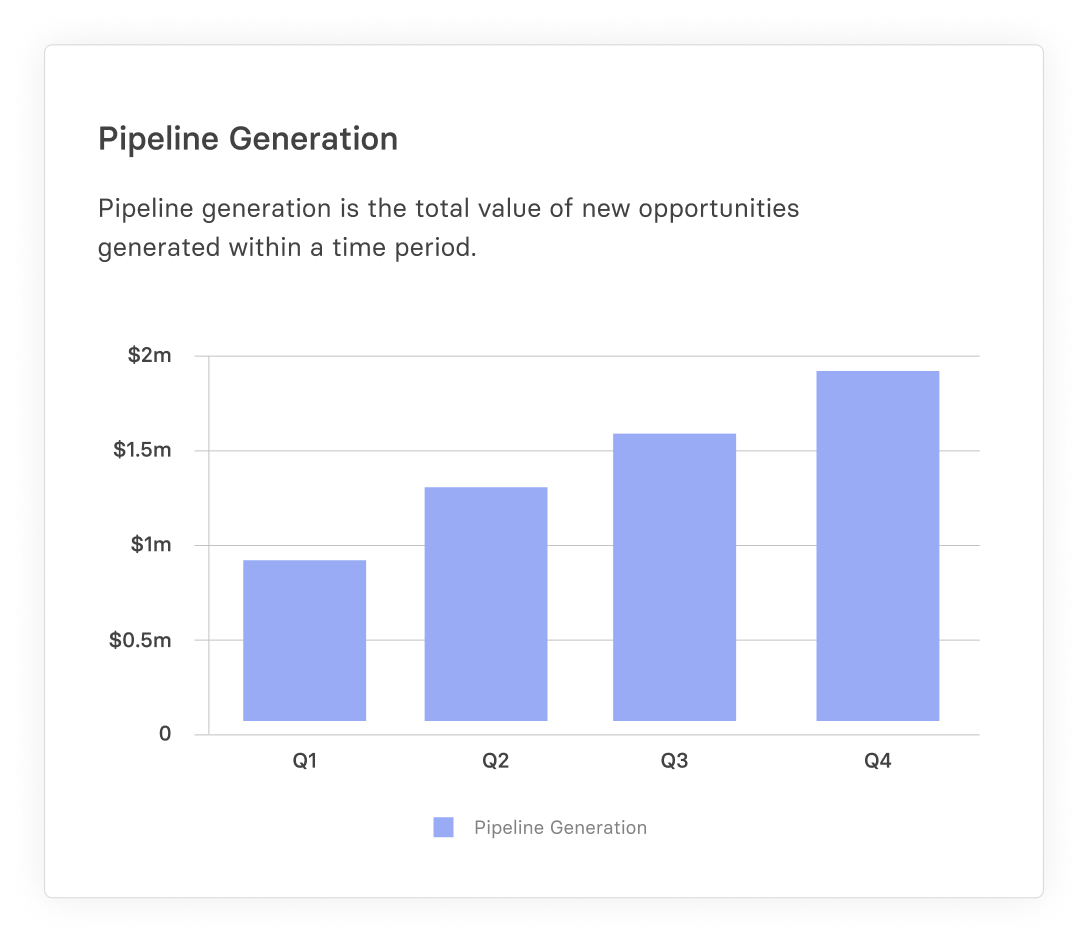Pipeline Generation
What Is Pipeline Generation?
Pipeline generation is the process of creating and managing all the steps your potential prospects go through, from initial contact or awareness to the final purchase decision. Pipeline generation is the heart of your business, as it tracks and nurtures the entire buyer’s journey.
For finance teams, pipeline generation can provide important insights into future revenue streams and customer acquisition costs, making forecasting and allocating resources easier.

Categories
Table of Contents
Pipeline vs. Lead Generation
Pipeline generation is the strategic process of creating a flow of potential customers from their initial awareness of a product or service all the way to when they are considered marketing or sales qualified leads. Often, this nurturing process includes marketing and sales initiatives designed to attract and engage potential buyers. Pipeline generation is the essence of your business because it fills the sales pipeline with a healthy stream of high-quality prospects that have a higher probability of converting into paying customers.
On the flip side, lead generation is intended to attract leads, but not necessarily nurture customer relationships by addressing their needs at every stage of the buyer’s journey. In other words, the sales pipeline indicates immediate sales performance, which impacts long-term financial health.
| Pipeline Generation | Lead Generation | |
|---|---|---|
| What | Creates a flow of potential customers from awareness to qualified lead | Attracts new prospects that may eventually fill the sales funnel, but may not have buying intent |
| Why | The goal for pipeline generation is to fill the sales pipeline with high-quality prospects that have a high probability of converting into customers | The objective of lead generation is to attract a large number of people in your audience toward your brand, regardless of their readiness to buy |
| When | Involves creating a healthy stream of prospects at various stages of the buying process, which ensures a consistent flow of new business opportunities | The process creates a list of potential customers with varying degrees of interest and qualification, and often needs further qualification |
Think of pipeline generation as a precursor to building the sales pipeline. A well-planned, effective pipeline generation process will bring in a steady influx of prospects who will eventually be ready to purchase your product, directly impacting your company’s bottom line. For finance, pipeline generation influences your ability to predict revenue growth and manage cash flow. Plus, it gives you deep insights into sales performance metrics.
Meanwhile, lead generation only considers the number of leads in your sales pipeline, regardless of whether or not they’re qualified prospects. That said, just looking at the volume of leads created isn’t enough to understand your customers’ pain points or get the whole picture. That’s why pipeline generation is essential — it gives you insight into your customers’ behavior, especially when you consider the data in tandem with other key metrics, such as your LTV/CAC ratio.
It is extremely important to see how effective your sales and marketing function is by closely monitoring your lead to MQL (Marketing Qualified Leads) and SQL (Sales Qualified Leads) conversion rates, as well as your SQL to opportunity creation. This helps your sales and marketing team ensure they are targeting the right accounts with their ad dollars and outreach. The last piece is measuring your win rate against opportunities created. Understanding these ratios will help you inform your sales and marketing teams of exactly how much pipeline they need to create in order to hit the new business bookings forecast.
Lead generation and pipeline generation are two parts of a healthy and effective go-to-market machine.
Understanding if your company can generate a meaningful pipeline is paramount to ensuring your business can hit its growth goals. Oftentimes, companies aim to grow rapidly, but if the business can’t generate new pipeline, those growth goals may not be achievable.
Get The Sales Pipeline Waterfall Template
Calculating and Tracking Pipeline Generation with Mosaic
Typically, customer relationship management (CRM) software helps companies gather, analyze, and store necessary customer data such as contact information, interactions, purchases, assets, and proposals — this is meant to give you insights into customer behavior. Specifically, CRMs are supposed to present this data in a format that’s easy to share and understand, making it accessible to authorized team members and stakeholders.
But often, a finance leader joins a company only to find that the CRM setup doesn’t have the proper functionality or configuration to support their reporting needs. The problem? This stops you from taking a more forward-looking approach to your work; instead, you’re stuck in vicious cycles of retrospective reports because of intense, time-consuming manual work.
Analyzing Pipeline Generation Data in Mosaic
Even with a strong sales pipeline, if you don’t have a solid understanding of how each piece of data fits together, it can be impossible to grow your company. That’s where Mosaic comes in — it shifts the focus to strategic finance, letting you focus on high-impact work by pulling all the data you need from your CRM, sales, HRIS, ERP, and other systems to give you a single source of truth. After all, finance teams rarely have the luxury of building a new CRM from the ground up.

Calculating your pipeline metrics individually or frequently isn’t always easy, considering the volume of sales data and how quickly it changes. However, Mosaic lets you view all your sales pipeline metrics in one place, giving you deep insights into your sales team performance, simplifying revenue forecasting, and helping you understand customers’ purchase habits — thanks to the holistic look into all your metrics.
Moreover, Mosaic helps get your data together and also automates metric calculations and business processes like top-line reporting and planning. Plus, it makes it easy to visualize the data in sales dashboards, so even those who aren’t subject matter experts can grasp the financial story.
Additionally, Mosaic empowers you to analyze these sales pipeline metrics at a granular level. For instance, since Mosaic collects large volumes of data and captures the nuances, you can look at everything, from conversion rates to the SaaS magic number. You can see your pipeline from every angle and understand the “why” behind your numbers to support strategic decisions.
How Finance Can Help Sales and Marketing Teams Develop a Winning Pipeline Generation Strategy
A thorough pipeline strategy is one that considers the big picture and plans for the long game — it involves carefully mapping your funnel and nurturing your prospective buyers to guide them from awareness to sales.
In SaaS, the key to a winning pipeline generation strategy lies in deeply understanding your customers and ideal customer profile (ICP), knowing your target audience, and tailoring your offerings and content to address their needs. The best way to develop a winning strategy is via a strong finance-sales partnership.
4 Traits of a Highly Effective Finance-Sales Partnership

Sales teams and marketing teams need a strategy that considers multiple marketing channels — one that leverages content and email marketing campaigns, advertising, SEO, social media, and other tactics to reach prospects at different stages of the journey and supports closing deals. But these teams also need to work in tandem with finance to understand what the ideal target personas look like.
Finance teams can help by:
- Aligning sales and finance data to identify profitable customer segments and build an informed, data-driven strategy.
- Investing in technology that provides real-time sales and customer behavior insights.
- Identifying key metrics and KPIs to track, such as customer acquisition cost, lifetime value, and sales cycle length.
- Collaborating with sales and marketing to refine targeting and optimize spending.
- Allocating resources to the most effective strategies for efficient pipeline management.
- Using accurate cash flow forecasting and reforecasting to support strategic decisions.
- Refining strategy based on real-time analytics and data insights.
Most importantly, sales, finance, and marketing teams should work together to continuously measure and analyze your pipeline’s performance to identify opportunities for improvement and adjust strategy accordingly.
Mosaic Gives You Deep Insights Into Your Pipeline
Ultimately, the pipeline generation strategy from a finance perspective boils down to the data. Your sales pipeline metrics are vital in predicting potential cash shortfalls ahead of time and identifying ineffective pipeline generation efforts, making it possible to swiftly course correct.
To learn how Mosaic offers insights into pipeline generation and helps make strategic decisions, schedule a personalized demo.
Pipeline Generation FAQs
How does pipeline generation differ from lead generation?
Pipeline generation is the entire process of converting a lead into a paying customer, including all the steps along the way, from awareness and consideration to decision and loyalty. Lead generation, on the other hand, covers just the beginning, where you’re generating leads or trying to capture the interest of potential customers.
How can Mosaic help in tracking and analyzing pipeline generation?
What common challenges are faced in pipeline generation?
Explore Related Metrics
Own the of your business.




